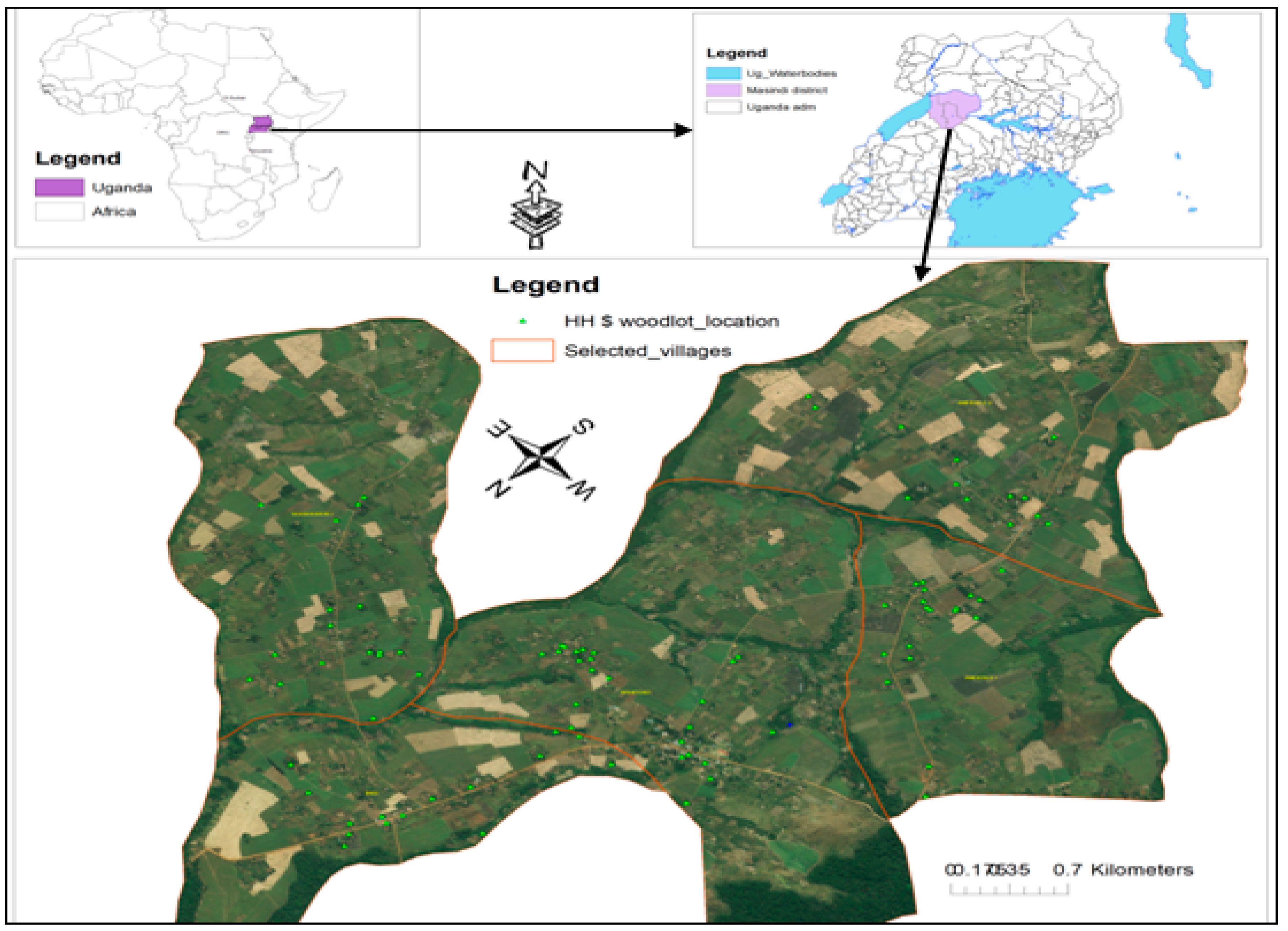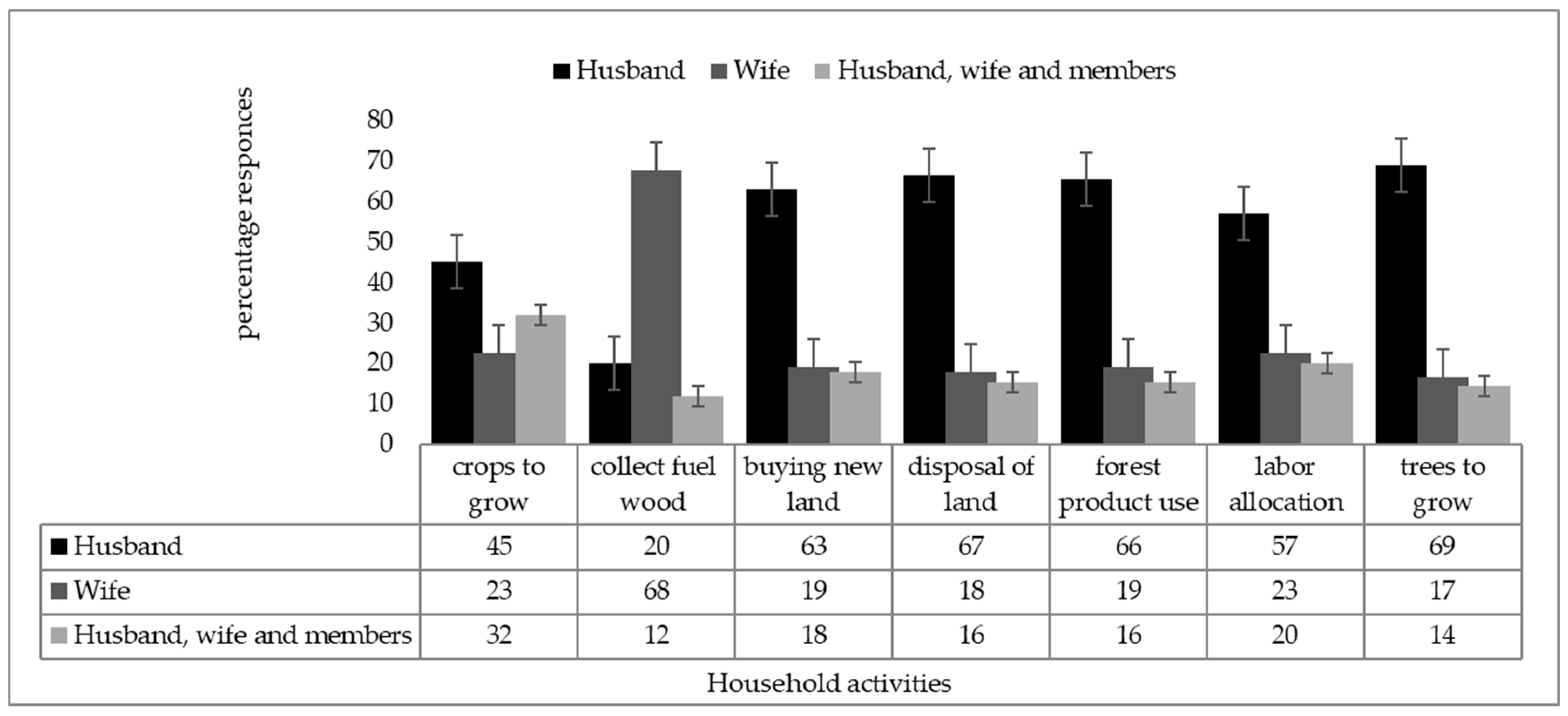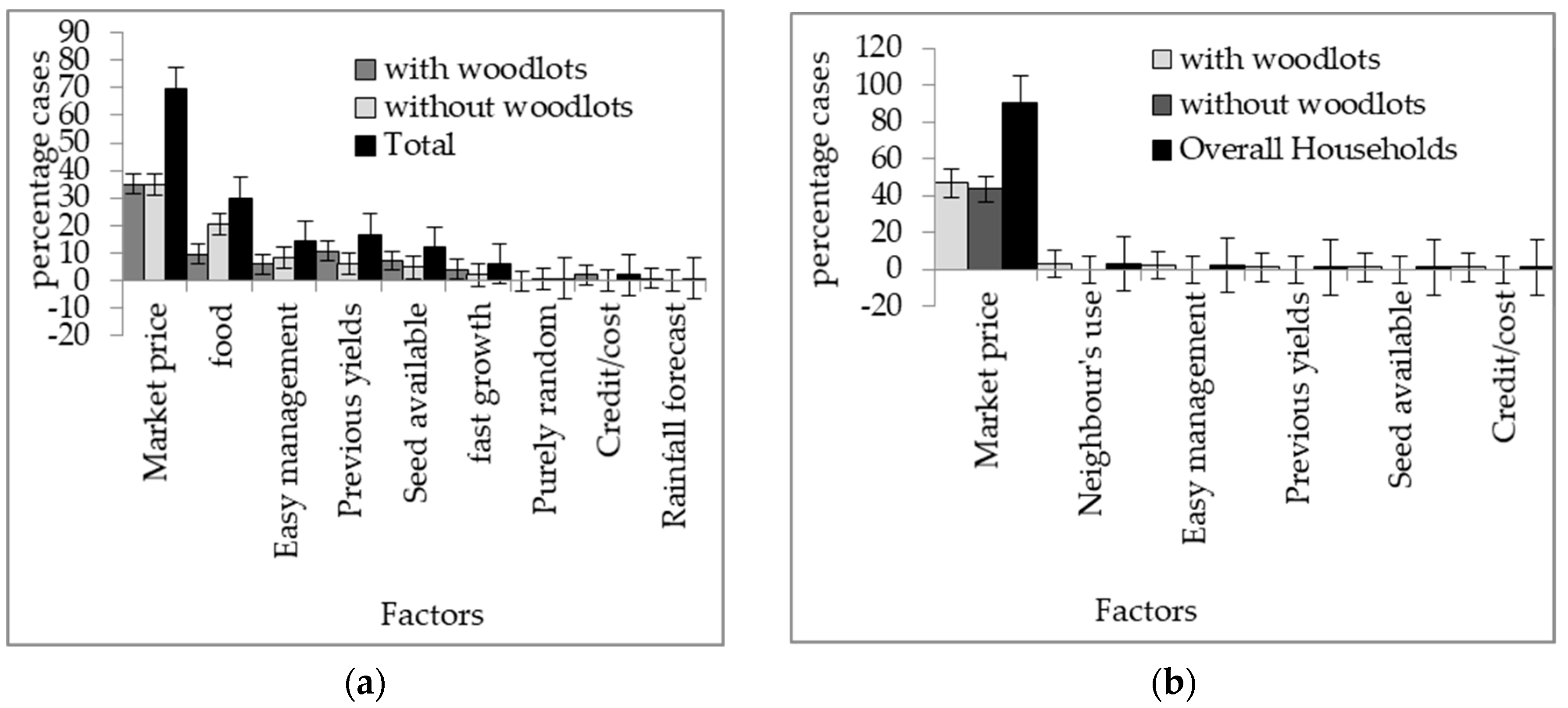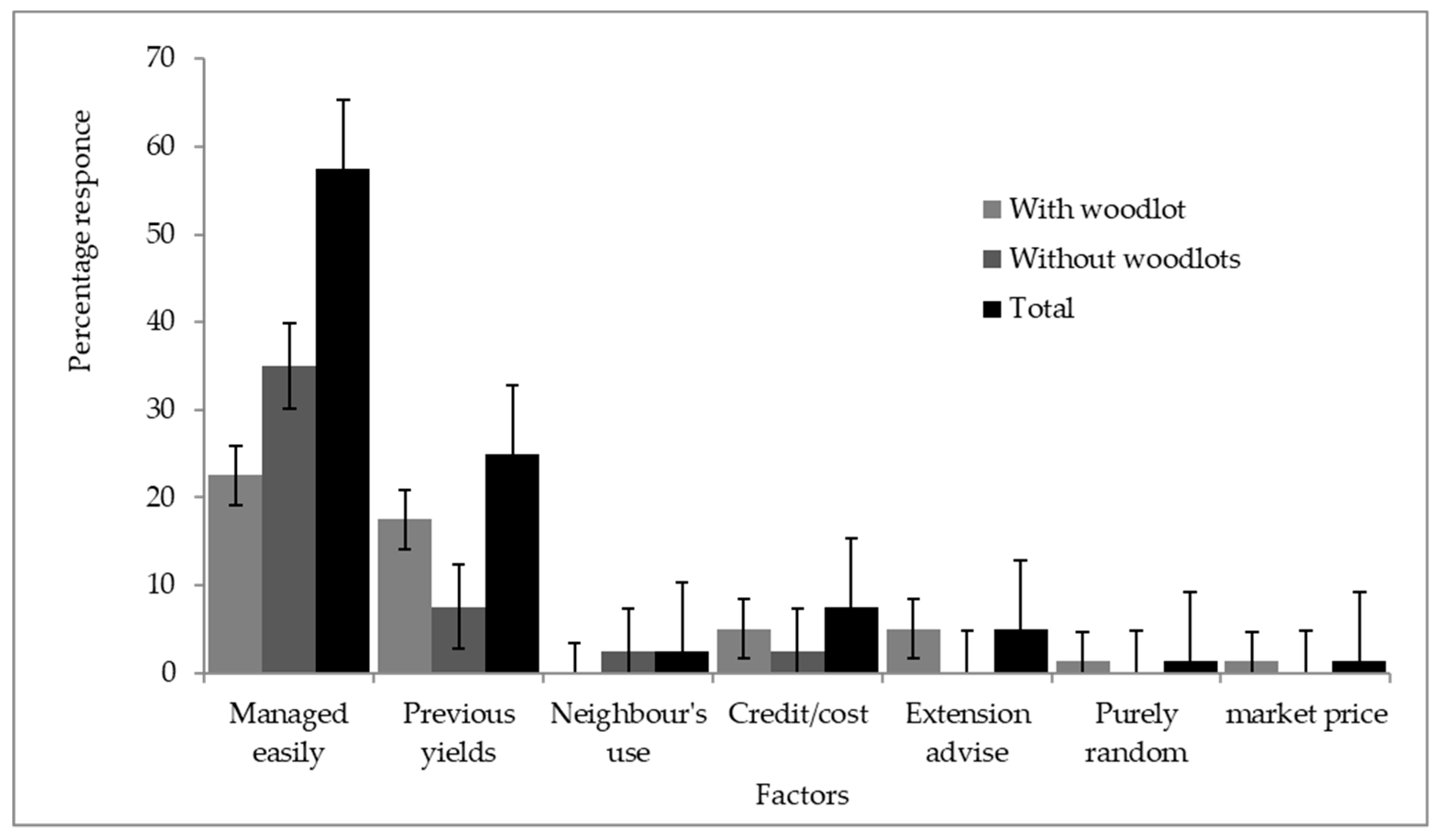Drivers of Household Decision-Making on Land-Use Transformation: An Example of Woodlot Establishment in Masindi District, Uganda
Abstract
:1. Introduction
- (1)
- What is the current status of gender-based decision-making at the household level?
- (2)
- Is decision making within farm households individualistic or collective?
- (3)
- Which factors are considered to select annual, perennial and tree-crop farm management regimes?
- (4)
- What determinants influence the decision-making process and the likelihood of woodlot establishment?
2. Methodology
2.1. Study Area Selection
2.2. Sampling
2.3. Data Collection
2.4. Data Analysis
3. Results
3.1. Differences in Household Endogenous and Demographic Traits and Intension to Woodlot Establishment
3.2. Decision-Making at the Household Level
3.2.1. Gender Disaggregate Decision-Making Behavior of Household
3.2.2. Household Decision to Select Perennial and Annual Crops and Management Regimes
3.2.3. Determinants That Influence Household Decision-Making with Respect to Woodlot Establishment
4. Discussion
4.1. Differences in Household Endogenous and Demographic Traits and Intension to Woodlot Establishment
4.2. Gender Disaggregate Decision-Making Behavior of Household
4.3. Household Decision-Making for Selection of Crops and Management Regimes
4.4. Determinants That Influence the Likelihood for Households’ Decision-Making to Woodlot Establishment
4.4.1. Age of Household Head
4.4.2. Access to Extra Source of Income “Non-Farm Income”
4.4.3. Knowledge on Land Use PLRs Towards Woodlot Establishment
4.4.4. Willingness and Future Plans to Change Land Use Activities Towards Woodlot Establishment
5. Conclusions and Policy Implications
Author Contributions
Funding
Acknowledgments
Conflicts of Interest
References
- Keenan, R.J.; Reams, G.A.; Achard, F.; De Freitas, J.V.; Grainger, A.; Lindquist, E. Dynamics of global forest area: Results from the FAO Global Forest Resources Assessment 2015. For. Ecol. Manag. 2015, 352, 9–20. [Google Scholar] [CrossRef]
- Song, X.-P.; Hansen, M.C.; Stehman, S.V.; Potapov, P.V.; Tyukavina, A.; Vermote, E.F.; Townshend, J.R. Global land change from 1982 to 2016. Nature 2018, 560, 639–643. [Google Scholar] [CrossRef]
- Geist, H.J.; Lambin, E.F. Proximate Causes and Underlying Driving Forces of Tropical Deforestation. BioScience 2002, 52, 143–150. [Google Scholar] [CrossRef]
- Gibbs, H.K.; Ruesch, A.S.; Achard, F.; Clayton, M.K.; Holmgren, P.; Ramankutty, N.; Foley, J.A. Tropical forests were the primary sources of new agricultural land in the 1980s and 1990s. Proc. Natl. Acad. Sci. USA 2010, 107, 16732–16737. [Google Scholar] [CrossRef] [PubMed] [Green Version]
- Ordway, E.M.; Asner, G.P.; Lambin, E.F. Deforestation risk due to commodity crop expansion in sub-Saharan Africa. Environ. Res. Lett. 2017, 12, 44015. [Google Scholar] [CrossRef]
- Curtis, P.G.; Slay, C.M.; Harris, N.L.; Tyukavina, A.; Hansen, M.C. Classifying drivers of global forest loss. Science 2018, 361, 1108–1111. [Google Scholar] [CrossRef]
- Peters, P.E. Land appropriation, surplus people and a battle over visions of agrarian futures in Africa. J. Peasant. Stud. 2013, 40, 537–562. [Google Scholar] [CrossRef]
- Tumusiime, D.M.; Vedeld, P.; Gombya-Ssembajjwe, W. Breaking the law? Illegal livelihoods from a Protected Area in Uganda. For. Policy Econ. 2011, 13, 273–283. [Google Scholar] [CrossRef]
- Twongyirwe, R.; Bithell, M.; Richards, K.S. Revisiting the drivers of deforestation in the tropics: Insights from local and key informant perceptions in western Uganda. J. Rural. Stud. 2018, 63, 105–119. [Google Scholar] [CrossRef] [Green Version]
- Naughton-Treves, L.; Kammen, D.M.; Chapman, C. Burning biodiversity: Woody biomass use by commercial and subsistence groups in western Uganda’s forests. Boil. Conserv. 2007, 134, 232–241. [Google Scholar] [CrossRef]
- Nabanoga, G.; Namaalwa, J.; Ssenyonjo, E. REDD and Sustainable Development, Perspective from Uganda REDD Working Papers; International Institute for Environment and Development (IIED): London, UK, 2010. [Google Scholar]
- Sassen, M.; Sheil, D.; Giller, K.E. Fuelwood collection and its impacts on a protected tropical mountain forest in Uganda. For. Ecol. Manag. 2015, 354, 56–67. [Google Scholar] [CrossRef]
- FAO. The State of the World’s Forests 2016; Food and Agriculture Organization of the United Nations: Rome, Italy, 2016. [Google Scholar]
- Ministry of Energy and Mineral Development (MEMD). Biomass Energy Strategy (BEST) Uganda. Available online: ttps://www.undp.org/content/dam/uganda/docs/UNDPUg2014%20-%20Biomass%20BEST%20Strategy(compressed).pdf (accessed on 12 April 2019).
- Dave, R.; Saint-Laurent, C.; Moraes, M.; Simonit, S.; Raes, L.; Karangwa, C. Bonn Challenge Barometer of Progress: Spotlight Report 2017. Available online: https://portals.iucn.org/library/sites/library/files/documents/2017-060.pdf (accessed on 3 March 2019).
- Ministry of Water and Environment (MWE). Forest Landscape Restoration Opportunity Assessment for Uganda 2016. Available online: https://portals.iucn.org/library/sites/library/files/documents/2016-076.pdf (accessed on 28 June 2019).
- Kiptot, E.; Franzel, S. Gender and agroforestry in Africa: A review of women’s participation. Agrofor. Syst. 2012, 84, 35–58. [Google Scholar] [CrossRef]
- Sabogal, C.; Casaza, J. Standing tall. In Exemplary Cases of Sustainable Forest Management in Latin America and the Caribbean; Food and Agriculture Organization of the United Nations (FAO): Santiago, Chile, 2010. [Google Scholar]
- Kiyingi, I.; Edriss, A.; Phiri, M.; Buyinza, M.; Agaba, H. The Impact of Farm Forestry on Poverty alleviation and Food Security in Uganda. J. Sustain. Dev. 2016, 9, 150. [Google Scholar] [CrossRef] [Green Version]
- Jayachandran, S.; De Laat, J.; Audy, R.; Lambin, E.F.; Stanton, C.Y.; E Thomas, N. Cash for carbon: A randomized trial of payments for ecosystem services to reduce deforestation. Science 2017, 357, 267–273. [Google Scholar] [CrossRef] [PubMed] [Green Version]
- Nguyen, Q.; Hoang, M.H.; Öborn, I.; van Noordwijk, M. Multipurpose agroforestry as a climate change resiliency option for farmers: An example of local adaptation in Vietnam. Clim. Chang. 2013, 117, 241–257. [Google Scholar] [CrossRef]
- Ministry of Water, Lands and Environment (MWLE). The National Forest Plan. Available online: https://www.mwe.go.ug/sites/default/files/National%20Forest%20Plan%20Uganda.pdf (accessed on 28 June 2019).
- Farley, K.A. Pathways to forest transition: Local case studies from the Ecuadorian Andes. J. Lat. Am. Geogr. 2010, 9, 7–26. [Google Scholar] [CrossRef]
- Dixon, J.; Gulliver, A.; Gibbon, D.; Hall, M. Farming Systems and Poverty. Improving Farmers’ Livelihoods in a Changing World; FAO and World Bank: Rome, Italy, 2001. [Google Scholar]
- Villamor, G.B.; Van Noordwijk, M. Gender specific land-use decisions and implications for ecosystem services in semi-matrilineal Sumatra. Glob. Environ. Chang. 2016, 39, 69–80. [Google Scholar] [CrossRef]
- Carroll, J.S.; Johnson, E.J. Decision Research. A field Guide; Sage Publications: Newbury Park, CA, USA, 1990. [Google Scholar]
- Negussie, A.D. Farm forestry decision making strategies of the Guraghe households, Southern-Central Highlands of Ethiopia. Available online: http://www.qucosa.de/fileadmin/data/qucosa/documents/1128/1081179280140-7980.pdf (accessed on 28 June 2019).
- Van Noordwijk, M.; Roshetko, J.M.; Angeles, M.D.; Fay, C.; Tomich, T.P. Farmer Tree Planting Barriers to Sustainable Forest Management. In Advances in Agroforestry; Springer Science and Business Media LLC: Berlin/Heidelberg, Germany, 2008; Volume 5, pp. 429–451. [Google Scholar]
- Angelsen, A.; Wunder, S. Exploring the Forest—Poverty Link: Key Concepts, Issues and Research Implications. Available online: http://www.cifor.org/publications/pdf_files/OccPapers/OP-40.pdf (accessed on 28 June 2019).
- French, J.H. Farm Household Decision Making and Extension Framework for Understanding Farm Household-Level Decision Making and Design of Agroforestry Extension Strategies; FAO/APAN: Bogor, Indonesia, 1995. [Google Scholar]
- Lambin, E.F.; Meyfroidt, P. Land use transitions: Socio-ecological feedback versus socio-economic change. Land Use Policy 2010, 27, 108–118. [Google Scholar] [CrossRef]
- DFID. Sustainable Livelihoods Guidance Sheets. Available online: https://www.ennonline.net/attachments/872/section2.pdf (accessed on 11 November 2018).
- BYRON, N. Keys to smallholder forestry. Forests, Trees Livelihoods 2001, 11, 279–294. [Google Scholar] [CrossRef]
- Deressa, T.T.; Hassan, R.M.; Ringler, C.; Alemu, T.; Yesuf, M. Determinants of farmers’ choice of adaptation methods to climate change in the Nile Basin of Ethiopia. Glob. Environ. Chang. 2009, 19, 248–255. [Google Scholar] [CrossRef]
- Collier, P.; Dorgan, J.; Bell, P. Factors Influencing Farmer Participation in Forestry; COFORD: Dublin, Ireland, 2002. [Google Scholar]
- Nigussie, Z.; Tsunekawa, A.; Haregeweyn, N.; Adgo, E.; Nohmi, M.; Tsubo, M.; Aklog, D.; Meshesha, D.T.; Abele, S. Factors Affecting Small-Scale Farmers’ Land Allocation and Tree Density Decisions in an Acacia decurrens-Based taungya System in Fagita Lekoma District, North-Western Ethiopia. Small-Scale For. 2017, 16, 219–233. [Google Scholar] [CrossRef]
- Simmons, C.S.; Walker, R.T.; Wood, C.H. Tree planting by small producers in the tropics: A comparative study of Brazil and Panama. Agrofor. Syst. 2002, 56, 89–105. [Google Scholar] [CrossRef]
- Sonkkila, S. Farmers’ Decision-Making on Adjustment into the EU. Available online: https://helda.helsinki.fi/bitstream/handle/10138/20924/farmersd.pdf?sequence=1 (accessed on 28 June 2019).
- Ajzen, I. The theory of planned behavior. Organ. Behav. Human Decis. Process. 1991, 50, 179–211. [Google Scholar] [CrossRef]
- Simon, H.A. A Behavioral Model of Rational Choice. Q. J. Econ. 1955, 69, 99. [Google Scholar] [CrossRef]
- Gigerenzer, G.; Selten, R. Bounded Rationality: The Adaptive Toolbox; Gigerenzer, G., Selten, R., Eds.; MIT Press: Cambridge, UK, 2001. [Google Scholar]
- Wahab, S.A. How Farmers Cope: Case Studies of Decision-Making in Six Farm Households in South of Malang, East Java. Ph.D. Thesis, Wageningen University, Wageningen, The Netherlands, 1996. [Google Scholar]
- Versteeg, S.; Hansen, C.P.; Pouliot, M. Factors influencing smallholder commercial tree planting in Isabel Province, the Solomon Islands. Agrofor. Syst. 2017, 91, 375–392. [Google Scholar] [CrossRef]
- Twongyirwe, R.; Bithell, M.; Richards, K.S.; Rees, W. Do livelihood typologies influence local perceptions of forest cover change? Evidence from a tropical forested and non-forested rural landscape in western Uganda. J. Rural. Stud. 2017, 50, 12–29. [Google Scholar] [CrossRef] [Green Version]
- Dessie, A.B.; Abtew, A.A.; Koye, A.D. Determinants of the production and commercial values of Eucalyptus woodlot products in Wogera District, Northern Ethiopia. Environ. Syst. Res. 2019, 8, 4. [Google Scholar] [CrossRef] [Green Version]
- Bernard, H.R. Research Methods in Anthropology, 5th ed.; Rowman & Littlefield: Lanham, MA, USA, 2011. [Google Scholar]
- IBM Corp. IBM SPSS Statistics for Windows; IBM Corp: Armonk, NY, USA, 2015. [Google Scholar]
- Landau, S.; Everitt, B. A Handbook of Statistical Analyses Using SPSS; Chapman & Hall/CRC: London, UK, 2004; ISBN 1-58488-369-3. [Google Scholar]
- Tefera, S.A.; Lerra, M.D. Determinants of Farmers Decision Making for Plant Eucalyptus Trees in Market District, North Willow, Ethiopia. Res. Humanit. Social Sci. 2016, 6, 62–70. [Google Scholar]
- Ndayambaje, J.D.; Heijman, W.J.M.; Mohren, G.M.J. Household Determinants of Tree Planting on Farms in Rural Rwanda. Small-Scale For. 2012, 11, 477–508. [Google Scholar] [CrossRef]
- Dytham, C. (Ed.) Choosing and Using Statistics. A Biologist’s Guide, 3rd ed.; Wiley-Blackwell: Oxford, UK, 2011; ISBN 1405198397. [Google Scholar]
- Gessesse, B.; Bewket, W.; Bräuning, A. Determinants of farmers’ tree-planting investment decisions as a degraded landscape management strategy in the central highlands of Ethiopia. Solid Earth 2016, 7, 639–650. [Google Scholar] [CrossRef]
- Harrison, S.R.; Herbohn, J.L. Sustainable Farm Forestry in the Tropics. Social and Economic Analysis and Policy; Edward Elgar: Cheltenham, UK, 2001. [Google Scholar]
- Kulindwa, Y.J. Key factors that influence households’ tree planting behaviour. Nat. Resour. Forum 2016, 40, 37–50. [Google Scholar] [CrossRef]
- Tenge, A.J.; de Graaff, J.; Hella, J.P. Social and economic factors affecting the adoption of soil and water conservation in West Usambara highlands. Tanzania. Land Degrad. Dev. 2004, 15, 99–114. [Google Scholar] [CrossRef]
- Miller, D.C.; Muñoz-Mora, J.C.; Christiaensen, L. Prevalence, economic contribution, and determinants of trees on farms across Sub-Saharan Africa. For. Policy Econ. 2017, 84, 47–61. [Google Scholar] [CrossRef] [Green Version]
- Schlüter, M.; Baeza, A.; Dressler, G.; Frank, K.; Groeneveld, J.; Jager, W.; Janssen, M.A.; McAllister, R.R.; Müller, B.; Orach, K.; et al. A framework for mapping and comparing behavioural theories in models of social-ecological systems. Ecol. Econ. 2017, 131, 21–35. [Google Scholar] [CrossRef]
- Abiyu, A.; Teketay, D.; Gratzer, G.; Shete, M. Tree Planting by Smallholder Farmers in the Upper Catchment of Lake Tana Watershed, Northwest Ethiopia. Small-Scale For. 2016, 15, 199–212. [Google Scholar] [CrossRef]
- Ashraf, J.; Pandey, R.; De Jong, W.; Nagar, B. Factors Influencing Farmers’ Decisions to Plant Trees on Their Farms in Uttar Pradesh, India. Small-Scale For. 2015, 14, 301–313. [Google Scholar] [CrossRef]
- Sood, K.K. Role of social aspects in extent of on-farm tree growing in subsistence agroforestry systems of Western Himalaya. Small-Scale For. Econ. Manag. Policy 2005, 4, 293–310. [Google Scholar]
- Franzel, S. Socioeconomic factors affecting the adoption potential of improved tree fallows in Africa. Agrofor. Syst. 1999, 47, 305–321. [Google Scholar] [CrossRef]
- Gebreegziabher, Z.; Mekonnen, A.; Kassie, M.; Köhlin, G.; Household Tree Planting in Tigrai, Northern Ethiopia: Tree Species, Purposes, and Determinants. Working Papers in Economics 2010. Available online: https://gupea.ub.gu.se/handle/2077/21995 (accessed on 28 June 2019).
- Duesberg, S.; Dhubháin, Á.N.; O’Connor, D. Assessing policy tools for encouraging farm afforestation in Ireland. Land Use Policy 2014, 38, 194–203. [Google Scholar] [CrossRef]
- Rahman, S.A.; Sunderland, T.; Roshetko, J.M.; Healey, J.R. Facilitating smallholder tree farming in fragmented tropical landscapes: Challenges and potentials for sustainable land management. J. Environ. Manag. 2017, 198, 110–121. [Google Scholar] [CrossRef] [Green Version]
- Roshetko, J.M. Smallholder Tree Farming Systems for Livelihood Enhancement and Carbon Storage. Ph.D. Thesis, University of Copenhagen, Frederiksberg, Denmark, 2013. [Google Scholar]




| Number of Households Sampled per Village | Sample Percentage Proportion per Village | ||||||
|---|---|---|---|---|---|---|---|
| Sample Villages | With Woodlot | Without Woodlot | Total Sample | Total Households | With Woodlot | Without Woodlot | Total Percentage |
| Nyantonzi | 17 | 12 | 29 | 98 | 17% | 12% | 30% |
| Siiba | 7 | 8 | 15 | 86 | 8% | 9% | 17% |
| Ekarakaveni 1 | 7 | 8 | 15 | 105 | 7% | 8% | 14% |
| Rwentare 1 | 6 | 7 | 13 | 50 | 12% | 14% | 26% |
| Rwentare 2 | 7 | 5 | 12 | 64 | 11% | 8% | 19% |
| Total | 44 | 40 | 84 | 403 | 11% | 10% | 21% |
| Variables | Households | t-Test (t-Ratio) | Pearson’s Chi-Square (χ2) | p-Values | |
|---|---|---|---|---|---|
| With Woodlots | Without Woodlots | ||||
| Physical capital | |||||
| Mean number of communication assets | 1.86 (0.51) | 1.6 (0.55) | 2.28 | 0.025 ** | |
| Mean number of transport facilities | 1.18 (0.39) | 1.05 (0.22) | 1.93 | 0.058 | |
| Mean number of farm equipment | 10.04 (4.68) | 8.98 (3.83) | 1.14 | 0.257 | |
| Natural capital | |||||
| Land tenure | 1.51 | 0.417 | |||
| Customary | 77% | 87% | |||
| Freehold | 2% | 3% | |||
| Leasehold | 21% | 10% | |||
| Total | 100% | 100% | |||
| Mean land holding size (ha) | 2.98 (2.2) | 2.21 (1.73) | 0.079 | ||
| Financial capital | |||||
| Mean number of livestock | 11.27 (11.25) | 9.97 (8.75) | 0.59 | 0.550 | |
| Access to non-farm income | 5.16 | 0.023 ** | |||
| With access | 43% | 20% | |||
| Without access | 57% | 80% | |||
| Total | 100% | 100% | |||
| Human capital | |||||
| Knowledge on PLRs | 8.61 | 0.003 ** | |||
| With knowledge | 30% | 5% | |||
| Without knowledge | 70% | 95% | |||
| Total | 100% | 100% | |||
| plans to change land use | 9.97 | 0.001 ** | |||
| With plans | 64% | 93% | |||
| Without plans | 36% | 7% | |||
| Total | 100% | 100% | |||
| Mean age of household head (years) | 49.50 (12.69) | 42.12 (11.03) | 2.83 | 0.006 ** | |
| Mean household size | 7.43 (2.90) | 6.09 (2.64) | 2.23 | 0.028 ** | |
| Mean available household labor (man-days) | 22.3 (16.38) | 18.25 (11.58) | 1.29 | 0.199 | |
| Mean available household labor per day (man-days) | 3.87 (1.92) | 3.46 (1.74) | 1.03 | 0.303 | |
| Mean external labor hired labor per season (man-days) | 11.45 (13.23) | 12.41 (13.19) | 0.33 | 0.742 | |
| Mean external labor used per day (man-days) | 3.81 (3.21) | 4.01 (3.52) | 0.27 | 0.784 | |
| Mean household labor used | 21.36 (15.54) | 17.25 (11.06) | 1.39 | 0.170 | |
| Mean household labor used per day (man-days) | 2.22 (0.95) | 1.92 (0.94) | 1.46 | 0.148 | |
| Mean number of household dependents | 5.47 (2.91) | 4.33 (2.46) | 1.95 | 0.055 | |
| Social capital | |||||
| Proportion of female headed households | 0.23 (0.42) | 0.1 (0.30) | 1.59 | 0.115 | |
| Household nativity | 1.33 | 0.515 | |||
| Native | 86.4% | 92.5% | |||
| Migrant | 11.4% | 7.5% | |||
| Unknown | 2.3% | 0% | |||
| Total | 100% | 100% | |||
| Variable Names | Definition of Variables | Unit of Variables |
|---|---|---|
| K_PLRs | Knowledge on land use policy law and regulations most especially those concerned with tree planting and harvesting; 1 = yes, 0 = otherwise | Binary |
| WandFP | Household members or household heads willingness and plan to transform their current land use towards woodlot establishment or expansion; 1 = yes, 0 = otherwise | Binary |
| EI | Household members or household heads that access to extra source of income (non-farm income) most especially remittances, private business and formal jobs; 1 = yes, 0 = otherwise | Binary |
| AH | Age of the household head | Continuous |
| TN_asset | Total number of household assets such as, Television used for communication and information sharing | Continuous |
| H_size | Household size defined by the sum of individual members within the household | Integer |
| Parameter | B | S.E. | Wald | df | Sig. | EXP(B) | 95% Confidence Interval for EXP(B) | |
|---|---|---|---|---|---|---|---|---|
| Lower | Upper | |||||||
| Age of household head | 0.072 | 0.024 | 9.097 | 1 | 0.003 ** | 1.075 | 1.026 | 1.126 |
| Access to extra nonfarm income | −1.312 | 0.63 | 4.34 | 1 | 0.037 * | 0.269 | 0.078 | 0.925 |
| Intention to change land use | 2.279 | 0.795 | 8.208 | 1 | 0.004 ** | 9.765 | 2.054 | 46.418 |
| Knowledge on land use PLR | −2.771 | 0.947 | 8.555 | 1 | 0.003 ** | 0.063 | 0.01 | 0.401 |
| Constant | −0.302 | 1.275 | 0.056 | 1 | 0.813 | 0.739 | ||
© 2019 by the authors. Licensee MDPI, Basel, Switzerland. This article is an open access article distributed under the terms and conditions of the Creative Commons Attribution (CC BY) license (http://creativecommons.org/licenses/by/4.0/).
Share and Cite
Ahimbisibwe, V.; Auch, E.; Groeneveld, J.; Tumwebaze, S.B.; Berger, U. Drivers of Household Decision-Making on Land-Use Transformation: An Example of Woodlot Establishment in Masindi District, Uganda. Forests 2019, 10, 619. https://doi.org/10.3390/f10080619
Ahimbisibwe V, Auch E, Groeneveld J, Tumwebaze SB, Berger U. Drivers of Household Decision-Making on Land-Use Transformation: An Example of Woodlot Establishment in Masindi District, Uganda. Forests. 2019; 10(8):619. https://doi.org/10.3390/f10080619
Chicago/Turabian StyleAhimbisibwe, Vianny, Eckhard Auch, Jürgen Groeneveld, Susan Balaba Tumwebaze, and Uta Berger. 2019. "Drivers of Household Decision-Making on Land-Use Transformation: An Example of Woodlot Establishment in Masindi District, Uganda" Forests 10, no. 8: 619. https://doi.org/10.3390/f10080619
APA StyleAhimbisibwe, V., Auch, E., Groeneveld, J., Tumwebaze, S. B., & Berger, U. (2019). Drivers of Household Decision-Making on Land-Use Transformation: An Example of Woodlot Establishment in Masindi District, Uganda. Forests, 10(8), 619. https://doi.org/10.3390/f10080619






